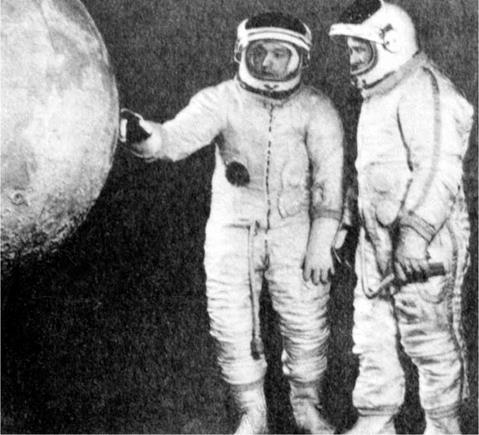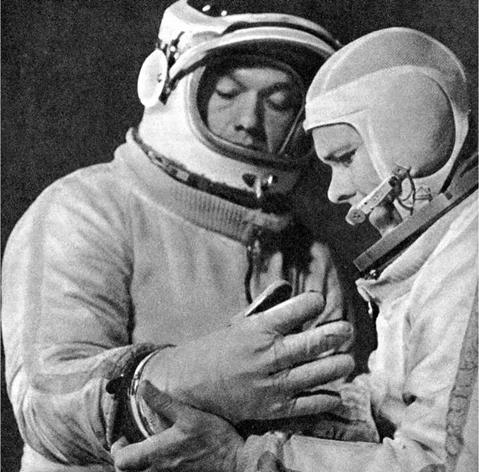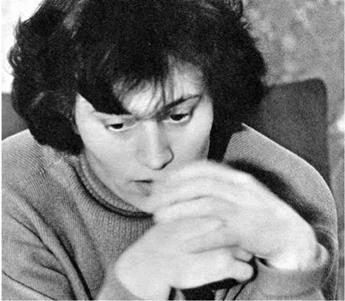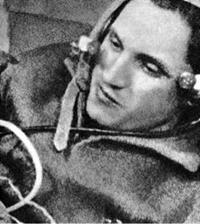SOYUZ 4-5 REHEARSE LUNAR DOCKING, SPACEWALKING
The failure of the first Lunokhod was disappointing, for the year had otherwise started well. In mid-January, two spacecraft had been launched to Venus, Venera 5 and Venera 6, using the now-improved Molniya rocket. More important, Soyuz had flown again, rehearsing key techniques that would be used during the lunar landing mission: rendezvous, docking and spacewalking.
A rendezvous and docking of two manned Soyuz was a natural progression from Soyuz 2 and 3 the previous October and indeed the roots of the mission went back to the ill-fated Komarov flight of 1967. It was a mission absolutely essential for the manned moon landing and that was why it was in the programme. The spacewalk would simulate the transfer of the mission commander between the LOK and the LK lunar lander. However, mindful of the additional new objectives of the space programme, the mission would now be hailed as an essential step towards an orbital station instead. It was a convincing explanation for Soyuz 4 and 5 and it took in everyone at the time – except for the chiefs of NASA and one of the populist British dailies, the savvy Daily Express, which ran the headline ‘Moon race!’ the next day.
Soyuz 4 was launched first, on 14th January, with Vladimir Shatalov on board. The mission was carried out under exceptionally demanding weather conditions, in temperatures of —22°C and snow around the launchpad. During mid-morning on the 15th, Vladimir Shatalov turned his Soyuz 4 towards the launch site to try and spot
|
Yevgeni Khrunov, Alexei Yeliseyev prepare for mission, lunar globe beside |
Soyuz 5 rising to reach him. The new spaceship blasted aloft with a full complement of three men aboard: Boris Volynov, Yevgeni Khrunov and engineer Alexei Yeliseyev.
The two spacecraft approached one other during the morning of the following day. Like seagulls with wings outstretched as they escort a ship at sea, Soyuz 4 inserted its pointed probe into 5’s drogue. Latches clawed at the probe, grabbed it tight, and sealed the system for manoeuvring, power and telephone. Moment of contact was 11: 20 a. m. over Soviet territory. Ground controllers listened with anxiety as the two ships high above came together and met. The Soviet Union had achieved the first docking between two manned spacecraft: a manoeuvre which, it was hoped, could one day soon take place when the LK returned to the LOK in lunar orbit.
No sooner had the cosmonauts settled down after their triumph than Khrunov and Yeliseyev struggled into their Yastreb spacesuits. This external crew transfer was an essential feature of the moon-landing profile, being required before the descent to the moon and again on the LK commander’s return. It was a slow process that could not be rushed. For his spacewalk, Leonov had already been dressed and ready to go,
|
Yevgeni Khrunov, Alexei Yeliseyev don spacesuits to rehearse lunar transfer |
but Khrunov and Yeliseyev had to put their suits on in the orbital module cabin – as the moon-landing commander would. There was layer upon layer to put on, inner garments, outer garments, heating systems, coolant, helmets, vizors and finally an autonomous backpack. Valves were checked through, seals examined. It was not that they had not practised it enough, it just had to be right this time of all times.
Khrunov pulled a lever and the air poured out of the orbital compartment. Vladimir Shatalov had already done the same in his orbital compartment, from the safe refuge of his command cabin. The pressure gauge fell rapidly and evened off to 0. Khrunov described what happened next:
The hatch opened and a stream of sunlight burst in. The Sun was unbearably bright and scorching. Only the thick filtering vizor saved my eyes. I saw the Earth and the black sky and had the same feeling I had experienced before my first parachute jumps.
The spectacle of the two docked craft was breath-taking, he recalled. He emerged, Yeliseyev following gingerly behind, moving one hand over another on the handrails. They filmed one other, inspected the craft for damage and watched the Earth roll past below. Within half an hour they were inside Soyuz 4. They closed the hatch and repressurized the cabin. The hatch into the Soyuz 4 command cabin opened, turned like a ship’s handle on a bulkhead. Vladimir Shatalov floated through and it was hugs and kisses all round. Now the Soviet Union had tested external crew transfer.
Triumph nearly turned to tragedy two days later. Soyuz 4, its crew now swollen to three, returned to Earth the following morning, coming down on hard snow in whistling winds laced with fine icy particles. The following morning was the turn of Soyuz 5 where Boris Volynov flew on, alone. First, Volynov missed his first landing opportunity due to a problem orientating the spacecraft. This was only the beginning of what could have been a very bad morning for the Soviet space programme [5]. When he did fire his retrorockets, the service module failed to separate from the descent module and Volynov’s cabin instead began to go into reentry head-first, the worst possible way. Without the benefit of heatshield protection, Volynov could feel the temperature rising in his cabin. He could smell the rubber seals burning off at the top of the capsule. Knowing the end was near, he radioed details of his predicament to ground control and hastily scribbled some last notes in his log should any parts of the cabin make it to the ground. Mission control was appalled at what had happened and faced the prospect of a second Soyuz reentry fatality in less than two years. One man broke the ice a little by passing around his military hat to collect some roubles for his prospective widow, Tamara.
|
Awaiting his return, Tamara Volynova |
|
Boris Volynov |
Back in space, Volynov heard a sudden but welcome thump as the service module finally separated. His burning descent cabin quickly spun round and at last faced the right way, heat shield forward, for reentry. Because there had been no time to orientate the spaceship properly to use its heatshield to generate lift, he was making a steep, 9 G ballistic descent, far from the normal landing site in the southern Urals. He landed in the dark in snow, miles from anywhere, where the local temperature was —38°C. Spinning partly tangled his parachute lines and then the touchdown rockets failed to fire, so the Soyuz hit the ground with great force, breaking some of the cosmonaut’s teeth. Clambering out of his still sizzling cabin, Volynov was afraid of freezing there, so he set out across the snow in his light coveralls in the direction of smoke on the horizon. The helicopter rescue crews soon found the cabin, but to their alarm, the cosmonaut was now missing! Thankfully, they were able to follow the trail of blood from his broken teeth across the snow and located him in an outhouse of local farmers. He couldn’t walk for three days.
If Volynov thought his ordeal was over, he was mistaken. His next challenge was to survive a political assassination. When he and his colleagues were welcomed back to Moscow the following week in a motorcade, a young lieutenant in uniform brandishing a gun started firing at the cavalcade. He was aiming at Leonid Brezhnev, but so wildly was he firing that he got the cosmonauts’ limousine instead. Its driver slumped over his wheel, dead, bleeding profusely. Beregovoi’s face was splattered with blood and glass. Nikolayev and Leonov pushed Valentina Tereskhova down onto the floor to protect her. The lieutenant was grabbed by the militia and taken off to an asylum, and that was where he spent the following 20 years. The awards ceremony went ahead as planned. Putting the memory of the afternoon behind them, Russia’s scientists bathed in the glow of their achievement. Mstislav Keldysh promised:
The assembly of big, constantly operating orbital stations, interplanetary flights and advances in radio, television, and other branches of the national economy lie ahead.
A few Western reporters still needled him about the moon race. There was no plan to go to the moon at the moment, he said, but when asked to confirm that Russia had abandoned plans to go the moon altogether, the ever-honest Mstislav Keldysh would not. Soyuz 4 and 5 had successfully ticked off three key elements of the Soviet lunar plan – manned docking, external crew transfer and a new spacesuit – but adroit news management portrayed the mission as part of a plan for a space station instead. As for Volynov, he took a year to recover and the doctors told him he’d never fly again. But they midjudged this brave man: he was back in training by 1972 and he did fly again.
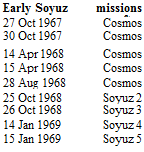

the first Sovuz
186
188
212
213
238
(Georgi Beregovoi)
(Vladimir Shatalov)
(Boris Volynov, Yevgeni Khrunov, Alexei Yeliseyev)











